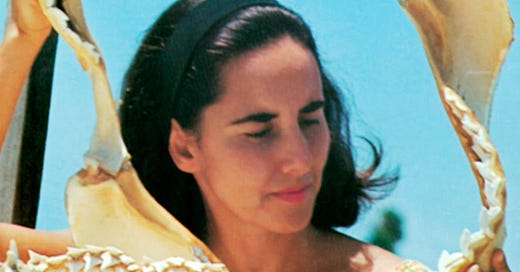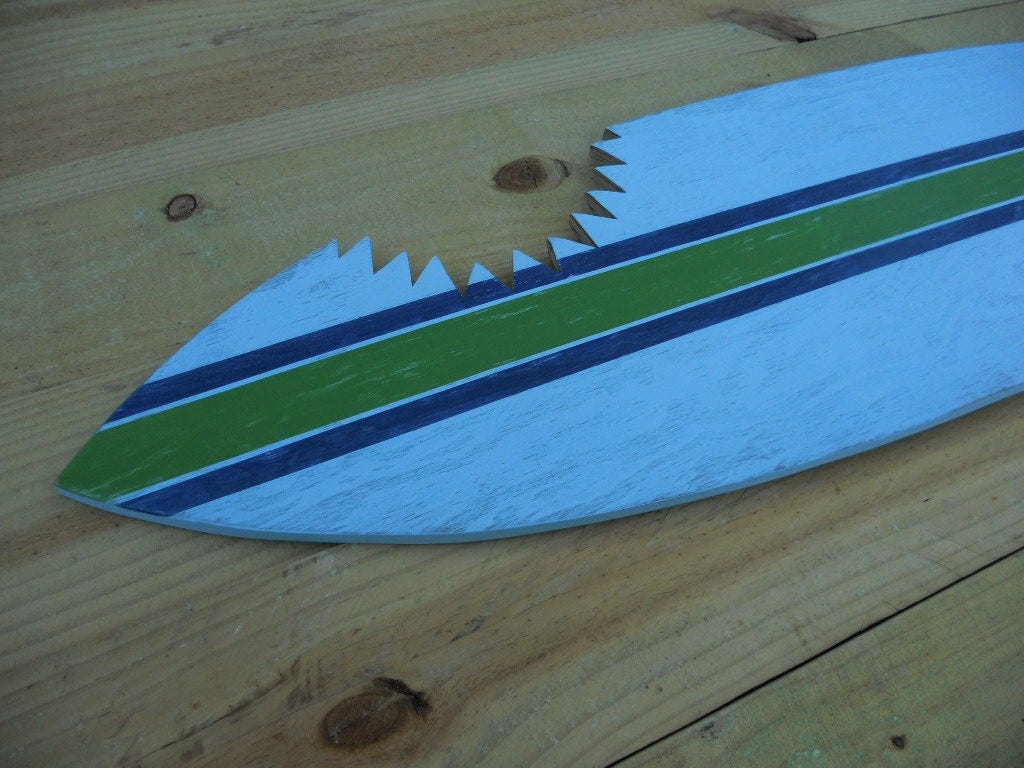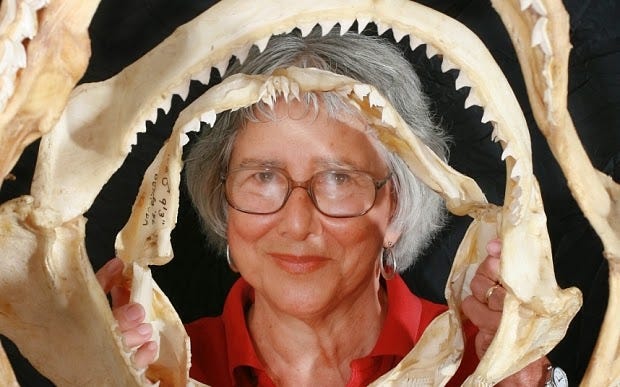Eugenie Clark, the Shark Lady [1922-2015]
"Sharks are beautiful animals, and if you're lucky enough to see lots of them, that means that you're in a healthy ocean. You should be afraid if you are in the ocean and don't see sharks."
[Since the 50th anniversary of a shark movie is being celebrated, and it’s that time of year when journalists get summer lazy with half the newsroom on vacation, they will dust off a lot of pre-written “shark attack“ stories and update them with recent facts. Or “facts.” I offer this repost of a five-year-old article to give balance to the alarmist practices of the media.]
I was once jammed onto an airplane in the midst of a gaggle of well-fed corporate men and women who were emotionally charged after attending a week long "team-work and incentive" conference in Las Vegas.
After the second pass of the liquor cart, my well-lubed cabin mates were dancing in the aisle to the caca-dulcet tones of Shakira and Justin Timberlake, poorly navigating the various armrests and safety features of the Boeing 767, and chanting slogans inherited from their conference.
Chief among them was "WE SWIM WITH SHARKS! WAHOO!!!"
Yes, it was a long flight.
One of the few things that lightened the ordeal was that I was traveling with a surf buddy and we had just spent the week driving up and down the Pacific Coast Highway surfing every beach that looked worthy of the stoke and whose local surf gang would permit us passage. After the fourth or fifth "WAHOO!!!", we traded a bemused look.
See, we had spent seven days literally swimming with sharks, and not as a corporate metaphor, and knew that it was hardly the pinnacle of physical or moral courage.
All it meant was that we had been in the water.
Now it's true that there have been injuries and fatalities associated with shark attacks on surfers, especially with that of friend-of-A Wandering Coracle, Bethany Hamilton. However, more surfers have drowned or suffered significant head trauma on submerged coral than have ever encountered a shark.
This writer has surfed for fifty-six years in various world waters and, while he has seen his share of the genus Carcharodon, he has never been menaced by them.
This is also true of the sharks encountered while bonefishing in the flats off the Florida Keys, sailing off of Cape Cod, and diving the older and undamaged Palancar Reef. They are always there, but they tend to keep their own counsel.
However, it goes without saying that sharks have a reputation. There was a time when it was common for ocean-going pleasure craft to carry "shark guns" on board. These were usually salt-water resistant shotguns or high caliber rifles. Ernest Hemingway famously employed a Thompson sub-machine gun on board his fishing boat, Pilar.
[Once, while attempting to kill a shark that had been hauled aboard while sail-fishing, he grazed himself in both legs. Shark 1 - Nobel Prize winner 0.]
There are also shark fishing competitions, specially designed shark spear guns and pneumatic knives, and multiple recipes for shark parts, popular in the Pacific Rim countries, that require an alarming level of slaughter.
There have been many, many movies and even a few novels that present sharks as a rapacious predator that will automatically attack any human in the water.
A few years back, a couple of Hawaiian surfers, tired of the waves being crowded by amateurs, took some old, broken surfboards, cut what looked like shark bites out of them, and allegedly distributed them about the beaches of the North Shore. Suddenly, the surf wasn't as crowded any more.
Hence, as with my plane cabin mates, the employment of the shark as a metaphor for danger is common even among those who work in some of the safest jobs ever known in human history.
It would take quite a novel thinker to work against that current of common thinking about sharks to truly study them and present their much more complicated role in the aquatic eco-system. A pioneer, of sorts.
Fortunately, a couple of New York City parents created such a pioneer when they decided in the early part of the 20th century to do something that nowadays would get them arrested and publicly shamed on a variety of news shows and social media. They would, on a near-daily basis, drop off their nine-year-old daughter at the New York Aquarium for her to spend the day, alone and un-escorted; a true "free-range" kid.
Instead of giving her a life's worth of trauma, as would be the case with some of the often soft, coddled children of the current age, it created in Eugenie Clark a robust curiosity about ocean life and eco-systems. She would, because of her parents’ "endangering" of her, become the pre-eminent expert on sharks and a pioneer for women in the field of marine biology.
Born in 1922, Clark's father died when she was still a toddler and her Japanese-American mother subsequently married the famous restaurateur, Nobu, which granted Clark the wherewithal to pursue the considerable academic work necessary for her field.
This included degrees in zoology from Hunter College and New York University and considerable research work done at Scripps Institute of Oceanography in California, its eastern counterpart, Woods Hole Oceanographic Institute of Massachusetts, and the American Museum of Natural History.
Some of her most significant work was done with the U.S. Office of Naval Research, which had both an astronomical budget and the absolute best in post-WWII technology for the study of the ocean.
Most of Clark's studies would take place among the atolls and islands of the South Pacific, including Micronesia, Melanesia, and the Marshall, Palau, and Marianas Islands. To further her research, it was necessary for her to be a proficient swimmer, certified scuba diver [I would remind the reader that this was before scuba diving became accessible and popular], and cave diver.
Again, she did this, too, at a time when it was so rare for a woman to be involved in these particular sciences that she gained the respectful sobriquet of "The Shark Lady".
While Clark studied a great many types of fish, it was her work with sharks that gained notoriety, as her research reversed many of the assumptions about sharks that were and are common.
She wrote numerous articles, both scholarly and popular, on the subject of sharks and published several books, including Lady With A Spear [1953] and The Lady With The Sharks [1969]1, and served as a mentor to numerous women in the biological sciences. She was also the founding director of what is now the Mote Marine Laboratory in western Florida.
Not only did she, in the midst of researching the biology of a rather dull flatfish, indirectly discover the most effective shark repellent yet produced, made from the secretions of a Pardachirus marmoratus [or Moses sole, a Red Sea dweller], but she also highlighted what was realistic in the feeding habits of sharks.
She insisted that “Jaws,” the 1975 Steven Spielberg film based on a Peter Benchley novel, and its sequels inspired unreasonable fears of sharks as ferocious killers. Car accidents are far more numerous and terrible than shark attacks, she said in a 1982 PBS documentary, “The Sharks.”
She said at the time that only about 50 shark attacks on humans were reported annually and that only 10 were fatal, and that the great white shark portrayed in “Jaws” would attack only if provoked, while most of the world’s 350 shark species were not dangerous to people at all.
“When you see a shark underwater,” she said, “you should say, ‘How lucky I am to see this beautiful animal in his environment.’ ”2
She was never attacked in any of her nearly 75 years literally swimming with sharks, and only once suffered a wound from one when a sample of a shark's jaws fell against her arm while she was driving to a lecture.
Her learned perspective and positive attitude towards even the most feared of sharks injects a necessary note of reality into any experience in the water. While care always needs to be taken in the open and untamed sea, it is a care born of common sense and a full understanding of one's surroundings, rather than that of ignorance and fear.
Actually, that’s a pretty good rule of life, too.
From The Daily Telegraph:
“Monster stories fascinate us,” she conceded, but people should not be afraid of sharks: “People want to know all the horrible details. And a shark attack can give you horrible details. People just can’t put it into perspective. We’ve learned, as most divers do, they’re not really dangerous at all. It’s no worse diving with sharks than it is driving a car down the road. The average shark, the more you swim around, scares off easily.”3
As was common in that era of publishing, the titles sound more like pulp thrillers than scientific studies.
from NYT’s “Eugenie Clark, Scholar of the Life Aquatic, Dies at 92”, March 7, 2015
from The Telegraph, “Ichthyologist who maintained that sharks do not deserve their fearsome reputation”, March 7, 2015







This gets me excited for Shark week!
I remember going to see Jaws at that wonderful old theater in Ocean City, New Jersey when it came out. I must say I was slightly afraid bro go in the water the next day. 🦈